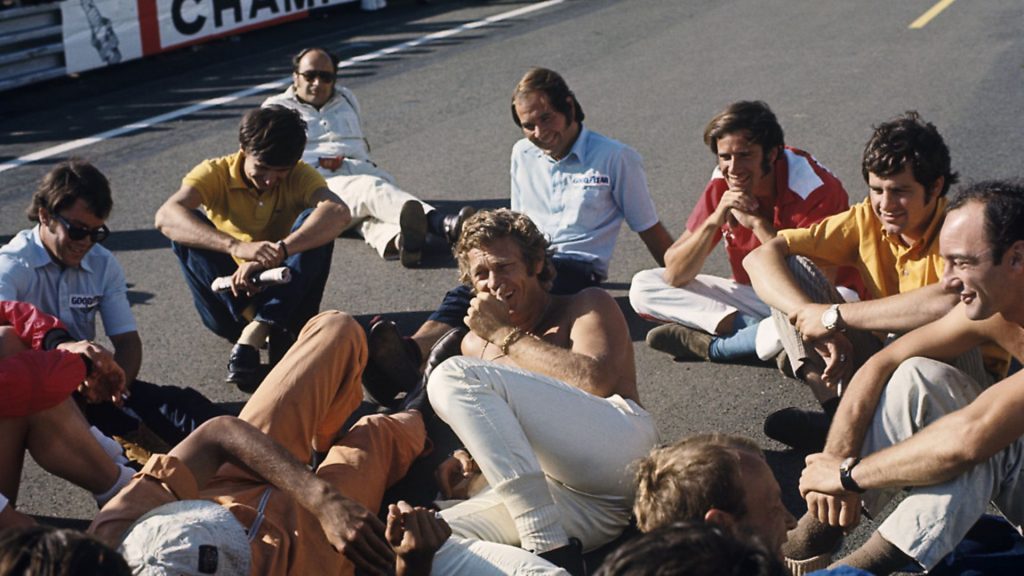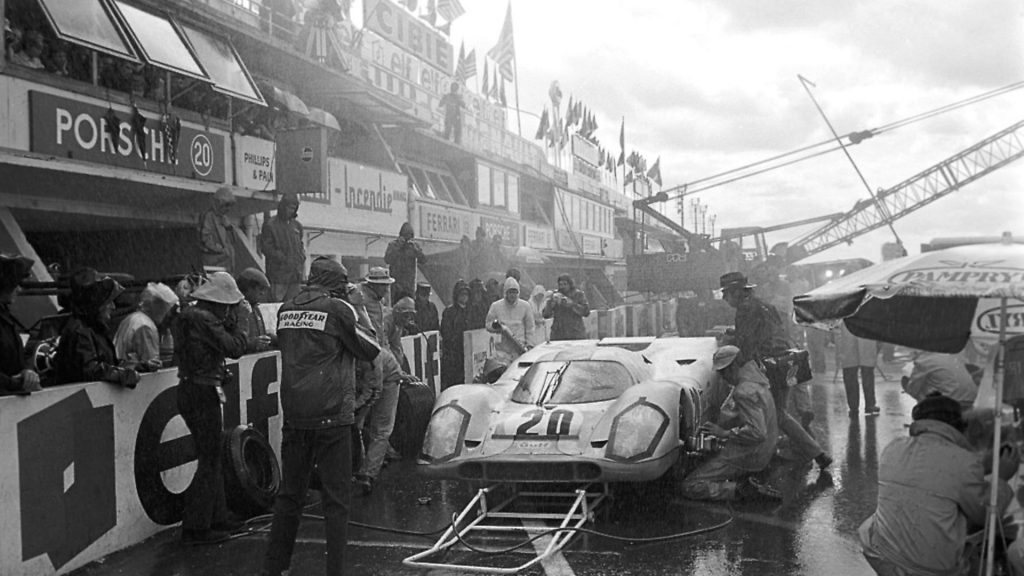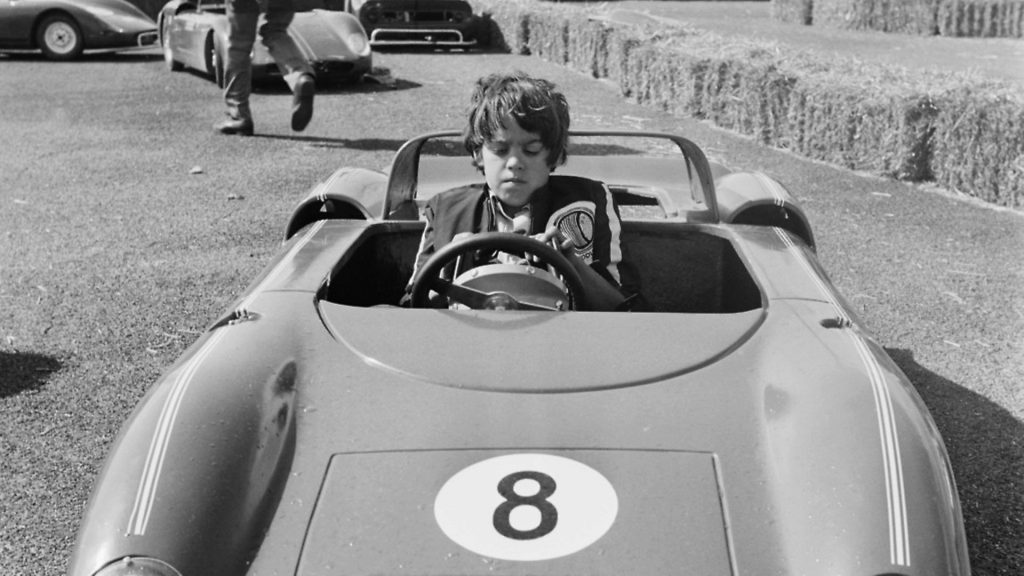
MICK O’HARE on the tortured background to Le Mans, the ill-starred film that has turned out to be Steve McQueen’s motorsport masterpiece.

Sometimes sport, despite its frequently overwrought and improbable hyperbole, invoking triumph and tragedy at every turn, throws up a genuinely heart-warming story.
Fifty years ago Hans Herrmann, veteran racing driver, former baker, journeyman racer, and all-round nice guy won the 1970 Le Mans 24-Hour race at his final attempt, 18 years after his first.
He had promised his wife he would retire after the race and with the victory garland still around his neck was true to his word. The previous year the German had agonisingly come second to the man who would eventually become a six-time-winner and Le Mans legend – Belgian Jacky Ickx – in the closest ever un-staged finish in the history of the race. It was the ultimate fairytale ending.
Yet despite the upbeat spirit generated by Herrmann’s popular victory, 1970 at Le Mans is remembered more for what was happening off the track, for it was the year Steve McQueen and Hollywood came to the races.

McQueen, of course, was famous for his acting, but he’d rather have been lauded for his racing. In 1970 he finished second at the Sebring 12-Hour race in Florida, often considered a warm-up for the Le Mans 24 Hours.
He proved to himself and, of substantially more importance to him, to his racing driver peers that he was their equal. It also proved to him that he was capable of making the film he had always wanted to make – the motor racing movie par excellence.
McQueen admitted he preferred the freedom of the track to the fakery of the studio and this movie was going to reflect that. It would be ‘authentic’ – one that racing drivers and aficionados would laud in perpetuity. And he would make it around the world’s most famous race, the Le Mans 24 Hours.
Every June (Covid-19 and world wars permitting) race fans converge on the Sarthe region of north-west France for the annual running of the 24-hour race. It starts on a Saturday afternoon, races non-stop through the night and finishes on Sunday – as many as 60 cars battling to be the first across the line when the chequered flag drops at the end of the most gruelling contest in the sport.

In his eponymous film McQueen wanted to capture the essence of what the drivers experienced – the challenge, the passion, the tactics, the competitive struggle, the ever-present threat of a life-changing or life-ending accident, the adrenaline, the exhaustion, and the glory or failure, the very essence of what racing was distilled into a movie – his magnum opus.
But it turned out the problem was, he cared too much. Schedule, budget, script (many of them), directors… all went out of the window as his obsession drove him on.
Back in 1966 John Frankenheimer had directed what had been regarded as the best motorsport film ever made. Grand Prix followed a fictional Formula 1 season (although real footage, alongside enacted racing, was shot for the movie throughout the 1966 season).
McQueen believed he could do better, although admitted his jealousy for the project and its star, fellow American James Garner, sometimes got the better of him.

It may be apocryphal but the story goes that at one point when he lived in an apartment above Garner’s in Hollywood Hills he gave vent to his envy by urinating on Garner’s pot plants on the plot below.
McQueen called Frankenheimer’s movie ‘a prime example of a director playing with himself in public’. He knew it wasn’t. He knew it was a great racing film, but professional rivalry ran deep, and while Grand Prix was admired widely by racing fans McQueen still reckoned parts of the story seemed improbable and some of the scenes clearly staged. He thought he could do better.
It was this obsession and an attention to detail that would nearly cause his movie to crash and burn. Certainly it destroyed his first marriage to Neile Adams. It also ruined his relationships with executive producer and former friend Bob Relyea and first director John Sturges, plus most of the people he came into contact with over his summer spent in France in 1970.
The movie was released the year after Herrmann’s victory, in 1971, to what are known as ‘mixed reviews’. What Hollywood could only see at the beginning as a sure-fire hit – McQueen, the ‘King of Cool’, in a fast car – had instead turned into what was described as ‘the most expensive documentary ever made’.

Critics disliked the lack of a real storyline and regular moviegoers, expecting the kind of action hero McQueen had played in The Magnificent Seven and Bullitt, couldn’t immediately grasp what motivated Michael Delaney, the more thoughtful character McQueen played in the movie.
Since then, it has been re-evaluated – most notably, but not exclusively, by motor racing fans – to become one of a handful of racing movies to achieve cult status. It has taken a while though.
Part of the problem with motor racing flicks is that the plot tends to be outlandish and the racing scenes contrived.
For all its fine acting by Christian Bale and Matt Damon, last year’s release Le Mans 66 suffers from the same.

Racing lines are non-existent, drivers seem able to overtake by simply pressing the accelerator a little harder, or finding an improbable extra gear. And they have time to snarl as they pass rivals.
There’s none of this in McQueen’s Le Mans. The first lap footage – nearly all of it genuine but interspersed with additional material – is superb, but the editing is key.
At any major meeting, but especially at Le Mans, for those near the startline there is a visceral moment of anticipation immediately before the race. The hubbub of the crowd fades as the start time approaches.
Le Mans captures this with almost painful intensity. Even the heartbeats of the drivers as they gaze at the starter seem uncontrived. A thousandth of a second before the flag falls, when engines are at their peak, waiting to be unleashed by overheating clutches, the cars remain stationary.

And then, at first almost imperceptibly, they slither away amid tyre smoke and squealing engines. Within a second they are jostling for position and gone around the first corner. It’s mesmerising, in equal measures beguiling and belligerent, and McQueen nailed it in fiction.
Further round the track the sense of anticipation is different. The crowd will have heard the distant roar of the start and know the cars are on their way. Then suddenly they burst into view, a cacophonic locust swarm.
This is true of any motor race, from everyday Mini Coopers to Formula 1. But the cars in Le Mans were the big beasts of 1970s sportscar racing – five-litre engines powering howling Porsches and grunting Ferraris, twitching and unstable with high fuel loads.
The grandstands shook as they passed. The movie shows the cars on their first lap down the long Mulsanne Straight, a 6km-long blast at full speed. They appear in the distance, as fortuitously a small bird lands on the barrier just in front of the camera. Then the cars are upon us, the bird takes flight and the might and pinnacle of automotive innovation hollers past and into the distance.

As a movie, perhaps it is understandable that it was poorly received by general film audiences. But for race fans especially, and with the benefit of 50 years of hindsight, that opening lap – a sequence which lasts a mere three minutes 46 seconds – would have been worth the entrance fee alone.
It’s impressive on DVD. On a big screen it is stunning. And there are more dramatic scenes in the wet – the spray cancelling out the view of the drivers leaving us glimpsing slithering tail lights amid an impenetrable mist, and out-of-focus headlights passing throughout the night sequences as the cars continue to circulate at up to 380 kilometres per hour. Every sound in the movie was real.
At this point – the end of the first lap – we are almost 31 minutes in and no-one has spoken. In fact no actor speaks a scripted line for the first 37 minutes.
McQueen wanted to immerse the viewer in what embodied a motor race, especially what embodied racing at Le Mans. He was a perfectionist and he feared ridicule from race fans more than from moviegoers, which is why the script suffered. The movie has fewer lines of dialogue than any other blockbuster made before or since – the actor playing the driver who eventually wins speaks only two lines in total – but that was only one of the project’s problems.
After his great successes of the 1960s, including The Great Escape and The Cincinnati Kid, McQueen decided he wanted creative control over the films he would make and set up Solar Productions with his trusted executive producer Relyea.
They signed a deal in March 1969 with Cinema Center Films to make Le Mans. Bob Rosen, executive in charge of production at CCF, knew it was a coup to have McQueen on board and initially allowed him pretty much free rein, aware that the actor wanted to make the ‘racing movie for all time. The definitive’.
McQueen hired director Sturges, with whom he had made The Great Escape and The Magnificent Seven. Filming began in June 1970, just before the race itself.
‘The plan was to shoot practice, qualifying and the race to get the real stuff, then wait for everybody to go home and shoot the rest of the movie to fill in the gaps,’ recalled Relyea in 2001, 12 years before his death.
Actors and real racing drivers, whom they had to remunerate, were added to the payroll, plus a whole bevy of technical support. But still there was no script and while it was relatively common for a movie to develop its storyline as filming progressed, McQueen simply couldn’t settle on one as scriptwriters came and went.
Each was attempting to please the studio with a storyline for a movie which – as far as McQueen was concerned – wasn’t meant to have one. He had no intention of using racing as a backdrop to an adventure story or a romance. To him, racing was the story. It was more like choreography than movie making.
Rosen said it was akin to McQueen ‘wanting to write the great American novel. He just couldn’t get it down on paper,’ His fellow actor, Siegfried Rauch, who played his on-track rival Erich Stahler, said: ‘It meant a lot to him. Almost everything.’
Truth is, McQueen actually wanted to race at Le Mans. He believed he’d earned the right after his Sebring success, but there was no way the studio and their jittery insurers would let that happen. It possibly clouded some of his judgment – demanding more of actors who didn’t have the same knowledge he had.
In an attempt to move things along McQueen contacted Alan Trustman, the man who had scripted some of his most successful movies, The Thomas Crown Affair and Bullitt. But, according to Rosen, McQueen was still contesting every line, every word, every comma.
Even Trustman left, disillusioned, giving up screenwriting for a life as a commodities trader. It got worse. McQueen was coming into conflict with Sturges as he tried to wrest direction from his control and admitted as much himself. ‘When something is close to you, you have a tendency to become too much of a perfectionist,’ he said in the documentary Steve McQueen: Le Mans and the Man. He was insisting that his character Michael Delaney lose the race, because that’s what could happen in reality. But the perplexed director and scriptwriters didn’t want to disappoint the studio who expected McQueen to win.
Sturges quit and flew back to America; he’d simply had enough. He remains uncredited on the movie. Filming was suspended and CCF, by now very edgy about the copious amounts of money that was being spent on Le Mans, stepped in.
McQueen was told that all he had to do was act. He was forced to sign a new contract (which he did, but wrote ‘in blood’ beneath his name) and had a new director imposed on him, Lee Katzin an unknown TV director from Detroit. McQueen didn’t know Katzin and Katzin knew nothing about motorsport. The actor-director animosity resumed.
But money and directors weren’t the only thing McQueen was losing – there was his marriage. Among many dalliances, McQueen was having an on-set affair with Swedish actress Louise Edlind, who played Anna Ritter, the wife of a driver.
Late one evening McQueen was driving Edlind home in the wet. He hit an unexpected turn at high speed and rolled the car. They were both battered and bruised but survived. McQueen realised that if the studio or the press got wind of what had happened his movie and career would be under further pressure.
They didn’t call an ambulance and arranged for Mario Iscovich, McQueen’s young personal assistant on the movie, to take the blame for the crash. But, in any case, Neile Adams was aware of what was going on in Europe. Edlind wasn’t McQueen’s only off-screen relationship. His wife finding his absence increasingly stressful and had an affair herself. Hypocritically, McQueen took this to mean the marriage was finished. They divorced two years later.
McQueen was also losing friends and colleagues as his obsession with the movie grew. His relationship soured irreparably with Relyea, whom he blamed for betraying him to the studio and forcing the new contract on him. They never spoke again.
But in September something happened. When McQueen was filming additional material he insisted on using real racing drivers in the cars. He also insisted on multiple takes to fit the various scripts he was still mulling over.
Motorsport in that era was a dangerous business, three-times Formula 1 champion Jackie Stewart has oft been quoted as saying you had a one in three chance of not making it through your career. British five-time Le Mans winner Derek Bell had already had a lucky escape with minor burns when his car burst into flames, but on the last extra take of the day, British sportscar racer David Piper crashed his car.
His seat stayed attached to the engine mounting as he was thrown into a field. That evening he had his right leg amputated. McQueen had finally reached the nadir. Had there been a script it’s likely Piper wouldn’t have been injured.
The next day McQueen told Katzin he would work with him and they would get the movie finished. From that moment, script, shooting and storyline came together. Nonetheless they were still filming additional material in November, at which point the crew was painting the russet leaves on the trackside green to simulate June. But the movie was made – it took a million feet of film, it was $1.5 million over budget and it was three months late.
It still made $22m when it opened the following year, exactly the same as the morally problematic but highly successful Dirty Harry starring Clint Eastwood, the other box-office-gold action-star turn of the day, yet movie critics still regard Le Mans as a minor hit at best.
In hindsight, the film was never made for the average movie-going audience, but as a project to document motorsport at Le Mans in perhaps its most golden of golden eras it was an overwhelming success. It is now regarded as the quintessential motorsports movie, a cult film in the sense that it transcended its mainstream intention. And the people who McQueen was so desperate to impress loved it. It’s probably all that mattered to him in the end.
‘It’s brilliant, actually a documentary, but still brilliant. It is like a fine vintage wine, it improves every time I see it,’ says Derek Bell. ‘Steve McQueen thought racing was as creative as film-making,’ he adds. Maybe being a driver or a fan helps but we should all perhaps be able to comprehend one person’s passion when we witness it. ‘Racing is life,’ says McQueen’s Delaney character in the movie. ‘Anything that happens before or after is just waiting.’ It’s a quote probably better known than the film itself and is a slogan many sports fans have adopted to their own favourite game and splashed across T-shirts.
Bob Rosen, despite all his misgivings, conceded that: ‘I think we captured what Steve wanted.’ McQueen, although he didn’t go to the premiere, having fallen out so spectacularly with the producers and the studio, was reportedly happy with his tour de force. ‘I wanted to get it down on film what I thought it was all about. You see what was in my mind,’ he told fans.
McQueen might have destroyed his marriage, lost personal control of his film, upset his directors, nearly killed a driver, spent way too much money and driven the studio to the point of apoplexy but he got his motor racing movie. He got his authenticity. Fifty years on, it’s still probably the finest of them all. And he gave James Garner a good enough reason to piss on his flower beds.
Warning: Illegal string offset 'link_id' in /mnt/storage/stage/www/wp-includes/bookmark.php on line 357
Notice: Trying to get property 'link_id' of non-object in /mnt/storage/stage/www/wp-includes/bookmark.php on line 37






